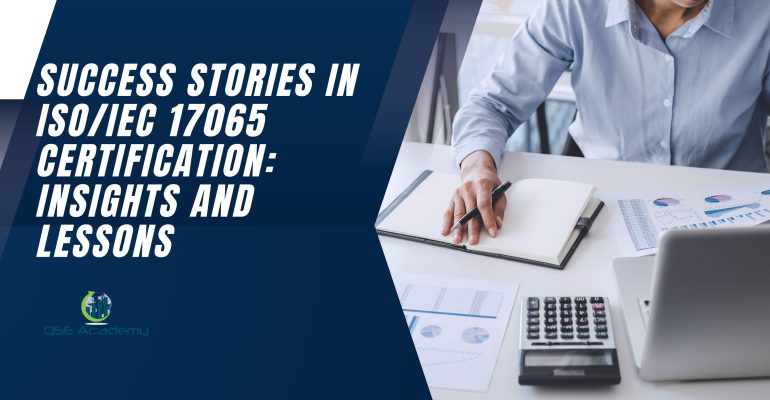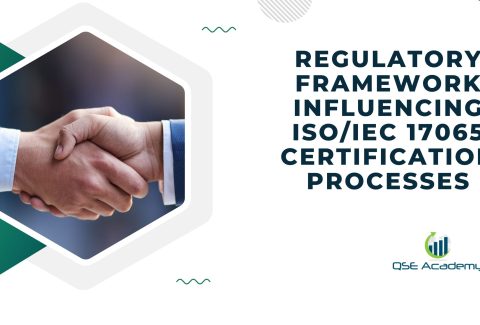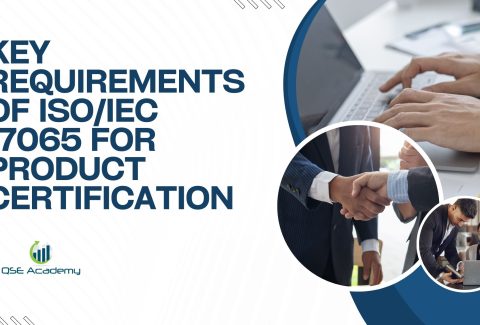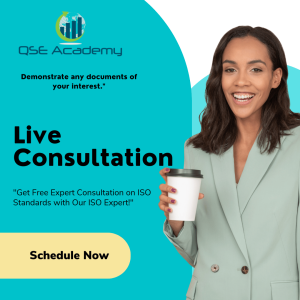Success Stories in ISO/IEC 17065 Certification: Insights and Lessons
Success Stories in ISO/IEC 17065 Certification: Insights and Lessons
Getting ISO/IEC 17065 certification can feel like a long and complicated journey. If you’re part of a certification body, you might be wondering: Is all this effort really worth it? Well, the short answer is yes! But don’t just take my word for it—let’s look at some real-life examples of organizations that have achieved ISO 17065 certification success and what we can learn from them.
In this article, we’ll explore ISO 17065 certification success stories that highlight the challenges, smart strategies, and lessons learned from certification bodies that made it through the process. Whether you’re a small organization trying to gain credibility, a large company looking to improve efficiency, or just curious about the benefits of this certification, these stories will give you valuable insights.
Achieving ISO 17065 certification isn’t just about ticking boxes—it’s about proving your credibility, gaining trust, and opening new opportunities. Some organizations have used it to expand their market reach, while others have leveraged it to streamline operations and improve efficiency. No matter your goal, these success stories show that with the right mindset and approach, certification is not just possible—it can be a game-changer for your business.
So, if you’re ready to discover how others have successfully navigated the process, let’s dive into these ISO 17065 certification success stories and see what we can learn!
What is ISO/IEC 17065 Certification and Why Does It Matter?
Before we jump into the ISO 17065 certification success stories, let’s take a moment to understand why this certification is so important and how it impacts certification bodies worldwide.
Imagine you’re buying an organic food product, a fire-resistant building material, or a cybersecurity-certified software. How do you know that these certifications are actually legit and trustworthy? That’s where ISO/IEC 17065 certification comes in.
This standard ensures that certification bodies—the organizations that approve and certify products, services, or processes—are operating fairly, consistently, and with full impartiality. In short, it guarantees that certifications are based on real, structured assessments rather than just marketing claims or biased decisions.
The Role of ISO 17065 in Certification
So, why does ISO 17065 certification matter? Because it’s all about credibility.
When a certification body gets ISO/IEC 17065 certified, it proves that:
✅ Their certification process is fair and transparent.
✅ They follow strict evaluation criteria, free from conflicts of interest.
✅ They maintain high levels of accuracy, competence, and consistency.
This is why many regulatory bodies, businesses, and even governments require certification bodies to be ISO 17065 accredited before they can approve or certify products and services. Without it, a certification might not be recognized or trusted internationally.
The organizations featured in our ISO 17065 certification success stories all had one thing in common: they used this certification as a tool to boost their reputation, expand into new markets, and gain a competitive edge.
The Road to Certification – A Challenging but Rewarding Journey
Achieving ISO/IEC 17065 certification isn’t something that happens overnight. In fact, many organizations face real challenges along the way, including:
🚧 Complex documentation requirements – Certification bodies must maintain detailed records for every decision they make.
🚧 Strict impartiality rules – They must prove they have no conflicts of interest when certifying products or services.
🚧 High competency standards – Their auditors and decision-makers need to be highly trained and qualified.
Despite these challenges, many organizations have successfully achieved ISO 17065 certification—and in the next section, we’ll explore some of the most inspiring ISO 17065 certification success stories and the key lessons we can learn from them.
Ready to see how others made it work? Let’s dive in!
ISO 17065 Certification Success Stories – Real-World Case Studies
Now that we understand the importance of ISO/IEC 17065 certification, let’s take a look at some real-life success stories. These organizations faced challenges, roadblocks, and tough decisions, but they pushed through and successfully achieved certification. Their journeys offer valuable lessons for any certification body looking to gain ISO 17065 accreditation.
Each of these ISO 17065 certification success stories highlights a different aspect of the process—whether it’s competing in a crowded industry, overcoming regulatory barriers, or streamlining operations. Let’s dive in!
Case Study #1 – A Small Certification Body Competing with Industry Giants
The Challenge:
A small certification body specializing in organic and sustainable agriculture faced a tough battle. They struggled to compete with larger, well-established certification organizations that already had strong reputations. Many businesses preferred working with big-name certifiers, leaving this small company struggling to gain trust.
The Strategy:
Instead of trying to out-market the competition, the company focused on proving its credibility through ISO 17065 certification. They streamlined their certification processes, strengthened their documentation practices, and trained their team to meet ISO 17065 standards.
The Success:
After achieving ISO 17065 certification, their credibility skyrocketed. Businesses that previously hesitated to work with them now saw them as a trusted, accredited certification body. Within a year, they secured contracts with several international organic food brands and expanded into new markets.
👉 Lesson Learned: Even small certification bodies can compete with industry giants by using ISO 17065 certification as proof of their credibility, fairness, and competence.
Case Study #2 – Overcoming Complex Compliance Barriers in the Food Industry
The Challenge:
A certification body specializing in food safety and organic certifications struggled with meeting complex regulatory requirements. Food safety standards vary across countries, and they needed to prove that their certification decisions were globally recognized and impartial.
The Strategy:
They worked closely with ISO consultants and conducted internal audits before applying for certification. They also upgraded their documentation system to ensure full compliance with ISO 17065 requirements.
The Success:
After earning ISO 17065 certification, their accreditation was accepted by major international food brands and retailers. This led to a 40% increase in certification requests from food manufacturers wanting to meet global standards.
👉 Lesson Learned: ISO 17065 certification can help certification bodies gain international recognition and acceptance, opening doors to global business opportunities.
Case Study #3 – Streamlining Certification Processes in a Large Organization
The Challenge:
A well-established certification body specializing in product safety certifications had one big problem—their processes were outdated and inefficient. They were slow to respond to clients, had inconsistent decision-making, and struggled with documentation management.
The Strategy:
To prepare for ISO 17065 certification, they:
✅ Implemented digital compliance tools to automate certification tracking.
✅ Redefined their internal auditing process to ensure consistency.
✅ Trained employees on best practices for maintaining impartiality and transparency.
The Success:
After achieving ISO 17065 certification, their efficiency improved dramatically. Processing times for certification requests decreased by 50%, client satisfaction ratings soared, and their reputation as a trusted certification body grew.
👉 Lesson Learned: ISO 17065 certification isn’t just about credibility—it also helps organizations streamline their operations, improve efficiency, and deliver better service.
Final Thoughts on These ISO 17065 Certification Success Stories
As these real-world examples show, ISO 17065 certification success stories come in all shapes and sizes. Whether it’s a small business proving its credibility, a certification body expanding internationally, or a large organization improving efficiency, the impact of ISO 17065 certification is undeniable.
In the next section, we’ll dive into the key lessons learned from these success stories and how your organization can apply them to achieve ISO 17065 certification smoothly. Stay tuned!
Key Lessons from ISO 17065 Certification Success Stories
After looking at real-world ISO 17065 certification success stories, one thing is clear—while the journey to certification comes with challenges, the rewards are absolutely worth it. But what exactly can we learn from organizations that have successfully achieved ISO 17065 certification?
In this section, we’ll break down the top lessons from these success stories so that your certification body can follow in their footsteps.
Lesson #1 – Preparation and Internal Audits are Game-Changers
One thing all ISO 17065 certification success stories have in common is that these organizations didn’t wait until the official audit to check for compliance. Instead, they conducted thorough internal audits to identify and fix any weaknesses before their certification assessment.
✅ Why this matters: Internal audits help you spot gaps early, so you’re not scrambling to fix major issues when the official audit happens.
✅ What to do: Set up regular internal reviews to assess your compliance with ISO 17065 requirements and make improvements before applying.
👉 Key takeaway: Treat internal audits like a practice test before the real exam—it’ll boost your chances of passing with flying colors!
Lesson #2 – Investing in Training Pays Off
In several ISO 17065 certification success stories, organizations highlighted the importance of training their employees—especially their auditors, decision-makers, and compliance teams.
✅ Why this matters: Having a well-trained team means fewer mistakes, better decision-making, and smoother certification processes.
✅ What to do: Provide ongoing training programs for staff to ensure they fully understand ISO 17065 requirements, certification processes, and compliance expectations.
👉 Key takeaway: The more knowledgeable your team is, the smoother and faster your certification journey will be.
Lesson #3 – Digital Tools Can Simplify Compliance
Several certification bodies that successfully earned ISO 17065 certification mentioned that managing documentation manually was one of their biggest challenges. To overcome this, they adopted digital tools to track applications, store records, and manage compliance workflows.
✅ Why this matters: Digital tools help reduce human error, improve efficiency, and make audits easier by keeping everything organized.
✅ What to do: Consider using certification management software or a document control system to keep track of all necessary records.
👉 Key takeaway: Technology can take a lot of the stress out of ISO 17065 certification—use it to your advantage!
Lesson #4 – Persistence and Patience Lead to Success
One major theme across all ISO 17065 certification success stories is that the journey takes time, and challenges will arise. Organizations that succeeded didn’t give up when things got difficult—instead, they stayed committed and focused on the bigger picture.
✅ Why this matters: ISO 17065 certification is a long-term investment in credibility and business growth.
✅ What to do: Be prepared for setbacks, but keep moving forward. If needed, seek help from ISO consultants or industry experts.
👉 Key takeaway: Success doesn’t happen overnight—but persistence, planning, and continuous improvement will get you there.
Final Thoughts on Lessons from ISO 17065 Certification Success Stories
These lessons from ISO 17065 certification success stories prove that with the right approach, any certification body can achieve accreditation. Whether it’s conducting internal audits, investing in training, using digital tools, or staying persistent, the key to success is preparation and continuous improvement.
In the next section, we’ll explore how your organization can apply these lessons to achieve ISO 17065 certification success. Ready to put these insights into action? Let’s go!
How Your Organization Can Achieve ISO 17065 Certification Success
After reading these ISO 17065 certification success stories, you might be wondering: How can my organization achieve the same level of success? The good news is, whether you’re a small certification body just starting out or a large organization looking to refine your processes, you can follow a proven path to ISO 17065 certification success.
In this section, we’ll walk through the key steps that will help your organization prepare, implement, and succeed in achieving ISO 17065 certification.
Step 1 – Understand the Requirements and Conduct a Gap Analysis
Before jumping into the certification process, it’s important to fully understand ISO 17065 requirements and compare them to your current operations.
✅ Why this matters: Many organizations rush into certification without knowing where they stand, leading to delays and unexpected challenges.
✅ What to do: Perform a gap analysis—a review of your current processes against ISO 17065 standards to identify areas that need improvement.
👉 Pro tip: Learn from the ISO 17065 certification success stories we shared earlier—every successful organization took time to analyze their weaknesses before applying.
Step 2 – Implement a Strong Quality Management System
One of the biggest takeaways from ISO 17065 certification success stories is that organizations with well-documented and standardized processes had a smoother certification journey.
✅ Why this matters: Certification bodies must prove they operate fairly, consistently, and transparently—which means having clear policies and procedures in place.
✅ What to do: Develop a structured quality management system (QMS) that includes:
- Clear guidelines for certification decisions
- Well-documented procedures for audits and assessments
- Defined roles and responsibilities within your organization
👉 Pro tip: Use digital tools to keep certification records organized and easily accessible—this was a common strategy in ISO 17065 certification success stories.
Step 3 – Seek Expert Guidance and Conduct Internal Audits
Organizations that successfully achieved ISO 17065 certification often mentioned the importance of expert support and internal audits in their journey.
✅ Why this matters: Many certification bodies struggle with understanding complex ISO requirements, and an expert’s guidance can help simplify the process.
✅ What to do:
- Hire an ISO consultant to help navigate ISO 17065 requirements.
- Conduct internal audits to identify any potential compliance issues before the official audit.
- Train employees on best practices for maintaining certification standards.
👉 Pro tip: Think of an internal audit as a trial run—it’s one of the best ways to catch and fix potential issues before the actual certification assessment.
Step 4 – Work with an Accredited Certification Body
Getting ISO 17065 certification is not something you can do internally—you’ll need to be assessed by an accredited certification body that can officially verify your compliance.
✅ Why this matters: Not all accreditation bodies have the same approach, so choosing the right one is crucial.
✅ What to do:
- Research and compare accredited certification bodies.
- Look for one that specializes in your industry or area of certification.
- Ensure they have experience with ISO 17065 assessments.
👉 Pro tip: Many organizations featured in ISO 17065 certification success stories built long-term partnerships with trusted accreditation bodies, helping them maintain compliance more effectively.
Final Thoughts on Achieving ISO 17065 Certification Success
Earning ISO 17065 certification might seem like a big challenge, but if you follow the right steps, it’s entirely achievable. By understanding the requirements, implementing a strong QMS, seeking expert guidance, and choosing the right certification body, your organization can join the ranks of successful certification bodies featured in our ISO 17065 certification success stories.
Ready to take the first step toward success? Start with a gap analysis, and remember—preparation and persistence are the keys to achieving ISO 17065 certification!
Conclusion – The Power of ISO 17065 Certification Success Stories
After exploring these ISO 17065 certification success stories, one thing is clear—achieving ISO/IEC 17065 certification isn’t just about meeting a standard; it’s about unlocking new opportunities, building trust, and strengthening your credibility as a certification body.
From small certification bodies competing with industry giants to large organizations streamlining their operations, every success story highlights the real impact of ISO 17065 certification. The common thread? Preparation, commitment, and continuous improvement.
Let’s recap the biggest takeaways from these ISO 17065 certification success stories:
✅ Preparation is key – Every successful organization started with a gap analysis to identify areas for improvement before applying for certification.
✅ Invest in training – Well-trained staff make a huge difference in maintaining compliance and ensuring smooth certification processes.
✅ Use technology to simplify compliance – Digital tools can streamline documentation and audit management, making certification easier to maintain.
✅ Choose the right accreditation partner – Working with an experienced certification body can make the process smoother and ensure long-term success.
Your ISO 17065 Certification Success Story Starts Today
If you’re considering ISO 17065 certification, let these success stories be your motivation. Whether you’re aiming to expand your market reach, improve efficiency, or strengthen your certification process, following the best practices outlined in these real-world examples will put you on the right path.
The journey to ISO 17065 certification may have its challenges, but with the right approach, preparation, and persistence, your organization can achieve success—just like the ones featured in these ISO 17065 certification success stories.
Are you ready to start your own success story? Take the first step today, and begin your journey toward ISO 17065 certification excellence!
I hold a Master’s degree in Quality Management, and I’ve built my career specializing in the ISO/IEC 17000 series standards, including ISO/IEC 17025, ISO 15189, ISO/IEC 17020, and ISO/IEC 17065. My background includes hands-on experience in accreditation preparation, documentation development, and internal auditing for laboratories and certification bodies. I’ve worked closely with teams in testing, calibration, inspection, and medical laboratories, helping them achieve and maintain compliance with international accreditation requirements. I’ve also received professional training in internal audits for ISO/IEC 17025 and ISO 15189, with practical involvement in managing nonconformities, improving quality systems, and aligning operations with standard requirements. At QSE Academy, I contribute technical content that turns complex accreditation standards into practical, step-by-step guidance for labs and assessors around the world. I’m passionate about supporting quality-driven organizations and making the path to accreditation clear, structured, and achievable.






















